Nissan Altima (L32) 2007-2012 Service Manual: P0456 Evap control system
DTC Logic
DTC DETECTION LOGIC
NOTE: If DTC P0456 is displayed with DTC P0442, first perform the trouble diagnosis for DTC P0456.
This diagnosis detects very small leakage in the EVAP line between fuel tank and EVAP canister purge volume control solenoid valve, using the negative pressure.
If ECM judges a leakage which corresponds to a very small leakage, the very small leakage P0456 will be detected.
If ECM judges a leakage equivalent to a small leakage, EVAP small leakage P0442 will be detected.
If ECM judges that there are no leakage, the diagnosis will be OK.
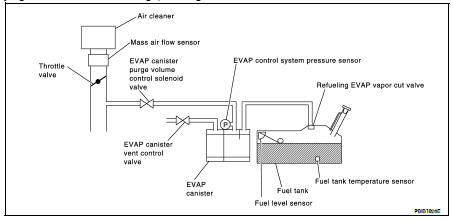
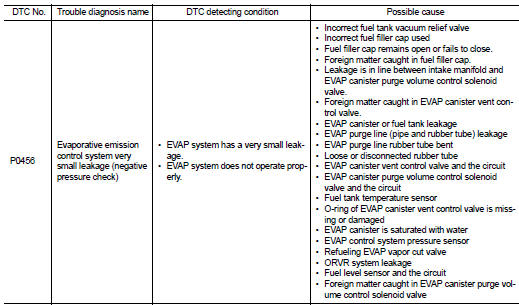
CAUTION:
• Use only a genuine NISSAN fuel filler cap as a replacement. If an incorrect fuel filler cap is used, the MIL may illuminate.
• If the fuel filler cap is not tightened properly, the MIL may illuminate.
• Use only a genuine NISSAN rubber tube as a replacement.
DTC CONFIRMATION PROCEDURE
1.PRECONDITIONING
If DTC Confirmation Procedure has been previously conducted, always perform the following before conducting the next test.
1. Turn ignition switch OFF and wait at least 10 seconds.
2. Turn ignition switch ON.
3. Turn ignition switch OFF and wait at least 10 seconds.
Will CONSULT-III be used? YES >> GO TO 2.
NO >> GO TO 4.
2.PRECONDITIONING
If DTC CONFIRMATION PROCEDURE has been previously conducted, always turn ignition switch OFF and wait at least 10 seconds before conducting the next test.
NOTE: • After repair, make sure that the hoses and clips are installed properly.
• Check that EVAP hoses are connected to EVAP canister purge volume control solenoid valve properly.
TESTING CONDITION: • Open engine hood before conducting the following procedure.
• If any of following conditions are met just before the DTC CONFIRMATION PROCEDURE, leave the vehicle for more than 1 hour.
- Fuel filler cap is removed.
- Fuel is refilled or drained.
- EVAP component part/parts is/are removed.
• Before performing the following procedure, confirm that battery voltage is more than 11 V at idle.
>> GO TO 3.
3.PERFORM DTC CONFIRMATION PROCEDURE

1. Turn ignition switch ON and select “DATA MONITOR” mode with CONSULT-III.
2. Make sure the following conditions are met.
FUEL LEVEL SE: 0.25 - 1.4 V COOLAN TEMP/S: 0 - 32°C (32 - 90°F) FUEL T/TMP SE: 0 - 35°C (32 - 95°F) INT A/TEMP SE: More than 0°C (32°F) If NG, turn ignition switch OFF and leave the vehicle in a cool place (soak the vehicle), or refill/drain fuel until the output voltage of the “FUEL LEVEL SE” meets within the range above and leave the vehicle for more than 1 hour. Then start from step 1.
3. Turn ignition switch OFF and wait at least 10 seconds.
4. Turn ignition switch ON.
5. Select “EVP V/S LEAKAGE P0456/P1456” of “EVAPORATIVE SYSTEM” in “DTC WORK SUPPORT” mode with CONSULT-III.
Follow the instructions displayed.
NOTE: If the engine speed cannot be maintained within the range displayed on CONSULT-III screen, go to EC-1048, "BASIC INSPECTION : Special Repair Requirement".
Which is displayed on CONSULT-III? OK >> INSPECTION END
NG >> Go to EC-1354, "Diagnosis Procedure".
4.PERFORM COMPONENT FUNCTION CHECK
Perform Component Function Check. Refer to EC-1354, "Component Function Check".
NOTE: Use Component Function Check to check the overall function of the EVAP very small leakage function. During this check, a 1st trip DTC might not be confirmed.
Is the inspection result normal? YES >> INSPECTION END
NO >> Go to EC-1354, "Diagnosis Procedure".
Component Function Check
1.PERFORM COMPONENT FUNCTION CHECK

CAUTION: • Never use compressed air, doing so may damage the EVAP system.
• Never start engine.
• Never exceeded 4.12 kPa (0.042 kg/cm2, 0.6 psi).
1. Attach the EVAP service port adapter (commercial service tool) securely to the EVAP service port.
2. Set the pressure pump and a hose.
3. Also set a vacuum gauge via the 3-way connector and a hose.
4. Turn ignition switch ON.
5. Connect GST and select Service $08.
6. Using Service $08 control the EVAP canister vent control valve (close).
7. Apply pressure and make sure the following conditions are satisfied.
Pressure to be applied: 2.7 kPa (0.028 kg/cm2, 0.39 psi) Time to be waited after the pressure drawn in to the EVAP system and the pressure to be dropped: 60 seconds and the pressure should not be dropped more than 0.4 kPa (0.004 kg/cm2, 0.06 psi). Is the inspection result normal? YES >> GO TO 2.
NO >> Go to EC-1354, "Diagnosis Procedure".
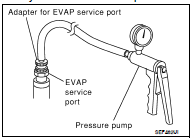
2.RELEASE PRESSURE
1. Disconnect GST.
2. Start engine and warm it up to normal operating temperature.
3. Turn ignition switch OFF and wait at least 10 seconds.
4. Restart engine and let it idle for 90 seconds.
5. Keep engine speed at 2,000 rpm for 30 seconds.
6. Turn ignition switch OFF.
NOTE: For more information, refer to GST Instruction Manual.
>> INSPECTION END
Diagnosis Procedure
1.CHECK FUEL FILLER CAP DESIGN
1. Turn ignition switch OFF.
2. Check for genuine NISSAN fuel filler cap design.
Is the inspection result normal? YES >> GO TO 2.
NO >> Replace with genuine NISSAN fuel filler cap.
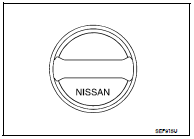
2.CHECK FUEL FILLER CAP INSTALLATION
Check that the cap is tightened properly by rotating the cap clockwise.
Is the inspection result normal? YES >> GO TO 3.
NO >> Open fuel filler cap, then clean cap and fuel filler neck threads using air blower. Retighten until ratcheting sound is heard.
3.CHECK FUEL FILLER CAP FUNCTION
Check for air releasing sound while opening the fuel filler cap.
Is the inspection result normal? YES >> GO TO 5.
NO >> GO TO 4.
4.CHECK FUEL TANK VACUUM RELIEF VALVE
Refer to EC-1358, "Component Inspection".
Is the inspection result normal? YES >> GO TO 5.
NO >> Replace fuel filler cap with a genuine one.
5.CHECK FOR EVAP LEAKAGE
Refer to EC-1581, "Inspection".
Is there any leakage in EVAP line? YES >> Repair or replace malfunctioning part.
NO >> GO TO 6.
6.CHECK EVAP CANISTER VENT CONTROL VALVE
Check the following.
• EVAP canister vent control valve is installed properly.
Refer to EC-1583, "Removal and Installation".
• EVAP canister vent control valve.
Refer to EC-1326, "Component Inspection".
Is the inspection result normal? YES >> GO TO 7.
NO >> Repair or replace EVAP canister vent control valve and O-ring.
7.CHECK IF EVAP CANISTER IS SATURATED WITH WATER
Remove EVAP canister with EVAP canister vent control valve and EVAP control system pressure sensor attached.
Does water drain from the EVAP canister? YES >> GO TO 8.
NO-1 >> With CONSULT-III: GO TO 10.
NO-2 >> Without CONSULT-III: GO TO 11.
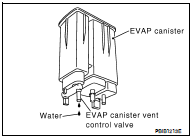
8.CHECK EVAP CANISTER
Weigh the EVAP canister with the EVAP canister vent control valve and EVAP control system pressure sensor attached.
The weight should be less than 2.1 kg (4.6 lb).
Is the inspection result normal? YES-1 >> With CONSULT-III: GO TO 10.
YES-2 >> Without CONSULT-III: GO TO 11.
NO >> GO TO 9.
9.DETECT MALFUNCTIONING PART
Check the following.
• EVAP canister for damage
• EVAP hose between EVAP canister and vehicle frame for clogging or poor connection
>> Repair hose or replace EVAP canister.
10.CHECK EVAP CANISTER PURGE VOLUME CONTROL SOLENOID VALVE OPERATION

1. Disconnect vacuum hose connected to EVAP service port and EVAP canister purge volume control solenoid valve from EVAP service port.
2. Start engine.
3. Perform “PURG VOL C/V” in “ACTIVE TEST” mode.
4. Touch “Qu” on CONSULT-III screen to increase “PURG VOL C/V” opening to 100%.
5. Check vacuum hose for vacuum.
Vacuum should exist.
Is the inspection result normal? YES >> GO TO 13.
NO >> GO TO 12.
11.CHECK EVAP CANISTER PURGE VOLUME CONTROL SOLENOID VALVE OPERATION

1. Start engine and warm it up to normal operating temperature.
2. Stop engine.
3. Disconnect vacuum hose connected to EVAP service port and EVAP canister purge volume control solenoid valve from EVAP service port.
4. Start engine and let it idle for at least 80 seconds.
5. Check vacuum hose for vacuum when revving engine up to 2,000 rpm.
Vacuum should exist.
Is the inspection result normal? YES >> GO TO 14.
NO >> GO TO 12.
12.CHECK VACUUM HOSE
Check vacuum hoses for clogging or disconnection. Refer to EC-1116, "System Diagram".
Is the inspection result normal? YES >> GO TO 13.
NO >> Repair or reconnect the hose.
13.CHECK EVAP CANISTER PURGE VOLUME CONTROL SOLENOID VALVE
Refer to EC-1319, "Component Inspection".
Is the inspection result normal? YES >> GO TO 14.
NO >> Replace EVAP canister purge volume control solenoid valve.
14.CHECK FUEL TANK TEMPERATURE SENSOR
Refer to EC-1276, "Component Inspection".
Is the inspection result normal? YES >> GO TO 15.
NO >> Replace fuel level sensor unit.
15.CHECK EVAP CONTROL SYSTEM PRESSURE SENSOR
Refer to EC-1334, "Component Inspection".
Is the inspection result normal? YES >> GO TO 16.
NO >> Replace EVAP control system pressure sensor.
16.CHECK EVAP PURGE LINE
Check EVAP purge line (pipe, rubber tube, fuel tank and EVAP canister) for cracks or improper connection.
Refer to EC-1116, "System Diagram".
Is the inspection result normal? YES >> GO TO 17.
NO >> Repair or reconnect the hose.
17.CLEAN EVAP PURGE LINE
Clean EVAP purge line (pipe and rubber tube) using air blower.
>> GO TO 18.
18.CHECK EVAP/ORVR LINE
Check EVAP/ORVR line between EVAP canister and fuel tank for clogging, kinks, looseness and improper connection. For location, refer to EC-1497, "Description".
Is the inspection result normal? YES >> GO TO 19.
NO >> Repair or replace hoses and tubes.
19.CHECK RECIRCULATION LINE
Check recirculation line between fuel filler tube and fuel tank for clogging, kinks, cracks, looseness and improper connection.
Is the inspection result normal? YES >> GO TO 20.
NO >> Repair or replace hose, tube or fuel filler tube.
20.CHECK REFUELING EVAP VAPOR CUT VALVE
Refer to EC-1500, "Component Inspection".
Is the inspection result normal? YES >> GO TO 21.
NO >> Replace refueling EVAP vapor cut valve with fuel tank.
21.CHECK FUEL LEVEL SENSOR
Refer to MWI-47, "Component Inspection".
Is the inspection result normal?
YES >> GO TO 22.
NO >> Replace fuel level sensor unit.
22.CHECK INTERMITTENT INCIDENT
Refer to GI-42, "Intermittent Incident".
>> INSPECTION END
Component Inspection
1.CHECK FUEL FILLER CAP
1. Turn ignition switch OFF.
2. Remove fuel filler cap.
3. Wipe clean valve housing.
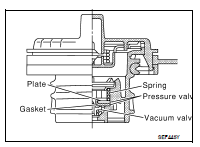
4. Install fuel filler cap adapter (commercial service tool) to fuel filler cap.
5. Check valve opening pressure and vacuum.
Pressure: 15.3 - 20.0 kPa (0.156 - 0.204 kg/cm2, 2.22 - 2.90 psi) Vacuum: −6.0 to −3.3 kPa (−0.061 to −0.034 kg/cm2, −0.87 to −0.48 psi)
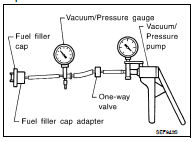
Is the inspection result normal? YES >> INSPECTION END
NO >> GO TO 2.
2.REPLACE FUEL FILLER CAP
Replace fuel filler cap.
CAUTION: Use only a genuine fuel filler cap as a replacement. If an incorrect fuel filler cap is used, the MIL may illuminate.
>> INSPECTION END

 P0455 Evap control system
P0455 Evap control system P0460 Fuel level sensor
P0460 Fuel level sensor